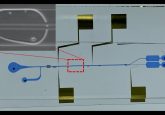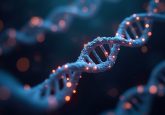New microfluidic platform increases microdroplet formation rate

Microfluidic devices — miniature platforms able to manipulate and analyze micrometer-sized liquid droplets — are crucial for biomolecular analysis and are widely used in capillary electrophoresis, immunoassays, flow cytometry, sample injection for mass spectrometry, etc. Despite the field of microfluidics being over 20 years old, microfluidic device applications are still hampered by the low productivity of microdroplets, with only a limited number of systems able to produce microdroplets at a high frequency.
An intuitive strategy for overcoming this bottleneck was led by Associate Professor Masumi Yamada from the Department of Applied Chemistry and Biotechnology at Chiba University (Japan). Yamada’s team unveiled a microfluidic system that leverages porous inverse colloidal crystals (ICCs) — a spongious matrix with regular, densely-formed interconnected micropores, which significantly improves microdroplet generation efficiency.
“We considered that highly efficient droplet formation might be possible by using the numerous micropores formed on the surface of the ICC structure as droplet-forming nozzles. However, to the best of our knowledge, no study has been reported on the integration of inverse colloidal crystal structures into microfluidic channels and their application to highly efficient droplet formation. Therefore, we decided to develop a new microfabrication technique to integrate these structures into microfluidic channels to achieve efficient droplet formation,” explained Dr Yamada.
You may also be interested in:
- Lab-on-a-Chip and Microfluidics Europe 2024
- The age of lab-on-a-chip technology – an interview with Aaron Wheeler
- What is lab-on-a-chip technology?
The study trialed the spongy ICC structures, which were integrated with planar microchannels functioning as tiny nozzles to produce microdroplets. These densely arranged micronozzles on the ICC microchannel enabled droplet formation ~1000 times faster than traditional microfluidic platforms. The droplet size could be adjusted by altering the flow of liquids, their properties and the micronozzle size. Biopolymer particles composed of polysaccharides and proteins were also produced by the device. Yamada continues:
“Microdroplets, biopolymer particles and vesicles fabricated from them as scaffolds, are widely used for medical applications such as drug development and regenerative medicine. Additionally, this method is expected to be applied to the production of various substances, including carriers for the controlled delivery of drugs, scaffolds for cell culture, reagents for cell transformation, carriers of antigens in cellular immunotherapy, and functional microparticles for diagnostics.”
Source: Mashiyama S, Hemmi R, Sato T, Kato A, Taniguchi T and Yamada M. Pushing the limits of microfluidic droplet production efficiency: engineering microchannels with seamlessly implemented 3D inverse colloidal crystals. Lab Chip. 24, 171–181 (2024).





